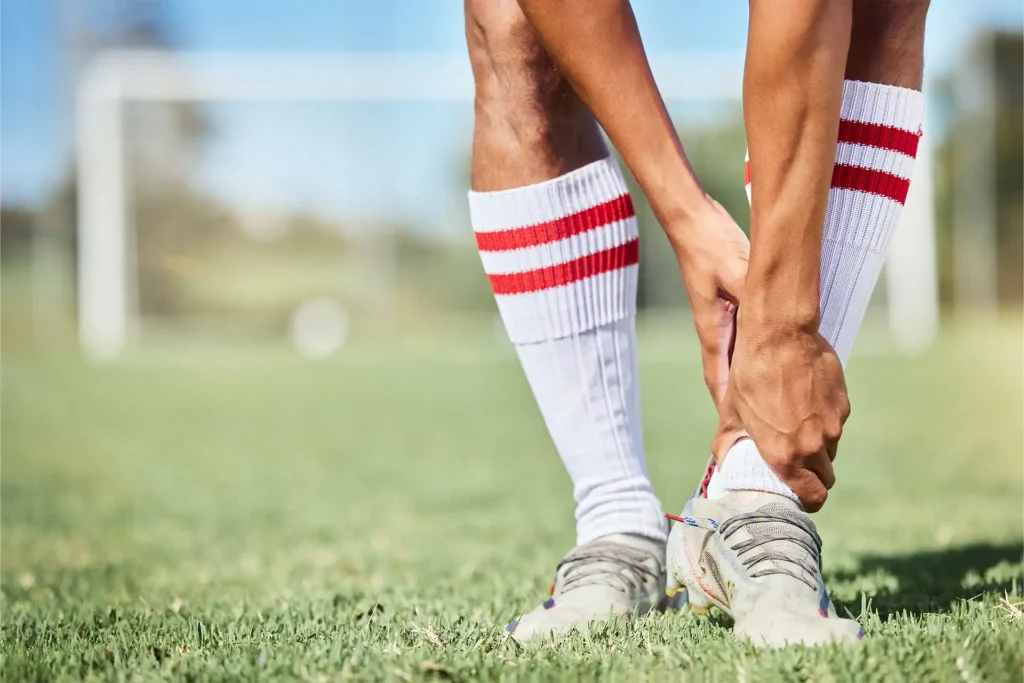If you live an active lifestyle, injuries are almost inevitable. Lifting weights, running marathons, or playing competitive sports can push your body to its limits. And while a little soreness after a workout is normal, sometimes that nagging pain means something more serious.
So, how do you know when it’s time to take a sports injury seriously? Let’s find out how to manage and prevent sports injuries so you can stay in the game.
Diagnosing Sports Injuries
Is It Just Soreness or an Injury?
After an intense workout or a tough game, muscle soreness is common. But when does soreness cross the line into injury territory? Here are a few telltale signs that something might be wrong:
- Pain that lingers or worsens over time
- Swelling or bruising around the affected area
- A popping or snapping feeling at the time of injury
- Difficulty moving the joint or limb normally
- Instability, weakness, or inability to bear weight
If you’re feeling any of these symptoms, it’s best to take a step back and assess the situation. Pushing through pain won’t make you stronger, it’ll just make the injury worse.
How Do Doctors Diagnose a Sports Injury?
When you visit a doctor or physiotherapist for a suspected sports injury, they’ll start with a physical examination, checking for swelling, tenderness, and range of motion issues. Depending on the severity of the injury, they might recommend further tests like:
- X-rays (to check for fractures)
- MRI or CT scans (to look at muscles, ligaments, and soft tissues)
- Ultrasound (for real-time imaging of tendons and muscles)
- Functional movement tests (to assess stability, strength, and flexibility)
A proper diagnosis is key to recovery as it will determine the most appropriate treatment and facilitate healing.
Sports Injury Management
The RICE Method: Your First Line of Defense
If you suspect an injury, your first instinct might be to shake it off and keep going. Bad idea. Instead, follow the RICE method (Rest, Ice, Compression, Elevation) within the first 24–48 hours:
- Rest: Stop whatever you’re doing and avoid stressing the injured body part.
- Ice: Press on ice packs for 15–20 minutes every couple of hours to reduce swelling.
- Compression: Bandage the injured area to minimise swelling and provide support.
- Elevation: Elevate the injured limb above heart level to reduce inflammation.
This simple method for sports injury management can significantly speed up the healing process for minor injuries like sprains and strains.
Non-Surgical Treatments: Rehab and Recovery
For many sports injuries, surgery isn’t necessary. In fact, most soft tissue injuries—like tendonitis, mild ligament sprains, or muscle strains—can heal with non-invasive treatments. These may include:
- Physical therapy to restore strength and flexibility
- Bracing or taping to stabilise the injured area
- Pain management through anti-inflammatory medications or corticosteroid injections
- Massage therapy breaks down scar tissue and improves circulation
The goal here is to heal properly and prevent re-injury. So, even if you start feeling better, don’t skip your rehab exercises. Your body will thank you later.
When Surgery Becomes Necessary
Sometimes, an injury is too severe to heal on its own. Torn ligaments (like ACL tears), complex fractures, or severe joint injuries may require surgery. Some standard procedures include:
- Arthroscopic surgery (minimally invasive joint surgery)
- Ligament reconstruction (like ACL or rotator cuff repairs)
- Fracture fixation (using plates, screws, or rods to stabilise broken bones)
If surgery is recommended, don’t panic. Sports medicine has advanced tremendously, and many athletes make full recoveries after surgery, often coming back stronger than before.
Steps to Take After an Injury
So, you’re injured. Now what? Here’s how to approach recovery the right way:
- Listen to your body. If something feels off, stop what you’re doing. Pushing through pain is not toughness but a one-way ticket to a worse injury.
- Follow your treatment plan. Whether it’s rest, physical therapy, or medication, stick with it. Skipping steps will only prolong recovery.
- Ease back into activity. The worst thing you can do is jump back into full intensity before your body is ready. Build up gradually.
- Stay consistent with rehab. Strengthening and mobility exercises are just as important as your workouts. Make them a part of your routine.
Recovering from an injury isn’t just about healing; it’s about coming back smarter and stronger.
Preventing Future Injuries
What is the best way to deal with injuries? Avoid them in the first place. Here’s how:
- Warm up properly. Dynamic stretching and mobility drills prepare your body for movement.
- Use proper technique. Whether lifting weights or sprinting, poor form leads to injuries. Get coaching if needed.
- Strengthen supporting muscles. Weak, stabilising muscles (like your glutes or core) make injuries more likely. Balance out your training.
- Prioritise recovery. Rest days, hydration, sleep, and good nutrition all contribute to injury prevention.
- Listen to warning signs. Aches and pains are your body’s way of saying, “Hey, something’s wrong.” Address issues early before they turn into serious injuries.
You don’t have to train harder, but you have to train smarter.
Consult a Sports Injury Doctor
Injuries are part of the game, but they don’t have to define your journey. If you’re struggling with persistent pain, swelling, or limited mobility that isn’t improving, it’s time to seek a sports injury doctor.
At ALPS Orthopaedic Sports Injury Clinic, our specialists can diagnose the problem, create a personalised treatment plan, and help you recover stronger than ever.
Don’t let an injury keep you sidelined; book an appointment to start sports injury management.

